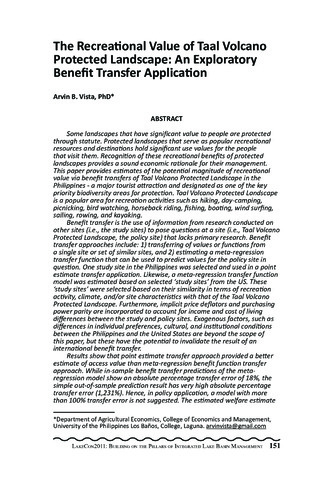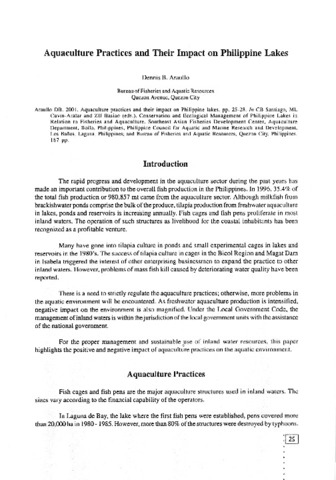The recreational value of Taal Volcano protected landscape: An exploratory benefit transfer application
- Global styles
- MLA
- Vancouver
- Elsevier - Harvard
- APA
- Help

View/
Date
2013Author
Page views
4,764ASFA keyword
AGROVOC keyword
Taxonomic term
Geographic names
Metadata
Show full item record
Share
Abstract
Some landscapes that have significant value to people are protected through statute. Protected landscapes that serve as popular recreational resources and destinations hold significant use values for the people that visit them. Recognition of these recreational benefits of protected landscapes provides a sound economic rationale for their management. This paper provides estimates of the potential magnitude of recreational value via benefit transfers of Taal Volcano Protected Landscape in the Philippines - a major tourist attraction and designated as one of the key priority biodiversity areas for protection. Taal Volcano Protected Landscape is a popular area for recreation activities such as hiking, day-camping, picnicking, bird watching, horseback riding, fishing, boating, wind surfing, sailing, rowing, and kayaking.
Benefit transfer is the use of information from research conducted on other sites (i.e., the study sites) to pose questions at a site (i.e., Taal Volcano Protected Landscape, the policy site) that lacks primary research. Benefit transfer approaches include: 1) transferring of values or functions from a single site or set of similar sites, and 2) estimating a meta-regression transfer function that can be used to predict values for the policy site in question. One study site in the Philippines was selected and used in a point estimate transfer application. Likewise, a meta-regression transfer function model was estimated based on selected study sites from the US. These study sites were selected based on their similarity in terms of recreation activity, climate, and/or site characteristics with that of the Taal Volcano Protected Landscape. Furthermore, implicit price deflators and purchasing power parity are incorporated to account for income and cost of living differences between the study and policy sites. Exogenous factors, such as differences in individual preferences, cultural, and institutional conditions between the Philippines and the United States are beyond the scope of this paper, but these have the potential to invalidate the result of an international benefit transfer.
Results show that point estimate transfer approach provided a better estimate of access value than meta-regression benefit function transfer approach. While in-sample benefit transfer predictions of the metaregression model show an absolute percentage transfer error of 18%, the simple out-of-sample prediction result has very high absolute percentage transfer error (1,231%). Hence, in policy application, a model with more than 100% transfer error is not suggested. The estimated welfare estimate of recreational access using point estimate transfer was P36/person per trip in 2006. The aggregated recreational benefits at the Taal Volcano Protected Landscape in 2006 was P9.7 million from 155,701 visitors at the Batangas side and P118.9 million from 1,906,242 visitors at the Cavite side, for a sum of about P128 million. This access value is not equivalent to economic resources that can be generated when visitor use fees is imposed to the users. User fees should be based on a willingness-to-pay (WTP) study that captures public perceptions and WTP fees, among others.
Suggested Citation
Vista, A. B. (2013). The recreational value of Taal Volcano protected landscape: An exploratory benefit transfer application. In M. L. C. Aralar, A. S. Borja, A. L. Palma, M. M. Mendoza, P. C. Ocampo, E. V. Manalili, & L. C. Darvin (Eds.), LakeCon2011: Building on the pillars of Integrated Lake Basin Management (Second National Congress on Philippine Lakes) (pp. 151-168). Los Baños, Laguna, Philippines: PCAARRD-DOST.
Type
Conference paperISSN
1656-8099Series
Summary of Proceedings No. 1/2013;Collections
- LakeCon2011 [30]
Related items
Showing items related by title, author, creator and subject.
-
Incidence and causes of mass fish kill in a shallow tropical eutrophic lake (Laguna de Bay, Philippines)
Cuvin-Aralar, Maria Lourdes; Santiago, Alejandro E.; Gonzal, Angelito C.; Santiago, Corazon B.; Romana-Eguia, Maria Rowena ; Baldia, Susana F.; Palisoc Jr., Fermin (Shiga Prefectural Government, 2001)
Mass fish kills in Laguna de Bay, the largest lake in the Philippines, has been reported as early as in the 1930’s. With the introduction of and development of aquaculture in this lake, considerable attention and concern ...
; Baldia, Susana F.; Palisoc Jr., Fermin (Shiga Prefectural Government, 2001)
Mass fish kills in Laguna de Bay, the largest lake in the Philippines, has been reported as early as in the 1930’s. With the introduction of and development of aquaculture in this lake, considerable attention and concern ... -
The decline of native fishes and fisheries and the rise of aquaculture in lakes and rivers in the Philippines
Bagarinao, Teodora (Aquaculture Department, Southeast Asian Fisheries Development Center; Philippine Council for Aquatic and Marine Research and Development (PCAMRD), Department of Science and Technology; Bureau of Fisheries and Aquatic Resources, 2001)
This paper reviews historical and recent data on biodiversity, fisheries, exotic fishes, and aquaculture in Philippine lakes and rivers. The country's lakes and rivers are poor in primary freshwater fishes because the ...
(Aquaculture Department, Southeast Asian Fisheries Development Center; Philippine Council for Aquatic and Marine Research and Development (PCAMRD), Department of Science and Technology; Bureau of Fisheries and Aquatic Resources, 2001)
This paper reviews historical and recent data on biodiversity, fisheries, exotic fishes, and aquaculture in Philippine lakes and rivers. The country's lakes and rivers are poor in primary freshwater fishes because the ... -
Aquaculture practices and their impact on Philippine Lakes
Araullo, Dennis B. (Aquaculture Department, Southeast Asian Fisheries Development Center; Philippine Council for Aquatic and Marine Research and Development (PCAMRD), Department of Science and Technology; Bureau of Fisheries and Aquatic Resources, 2001)The rapid progress and development in the aquaculture sector during the past years has made an important contribution to the overall fish production in the Philippines. In 1996, 35.4% of the total fish production or 980,857 ...






